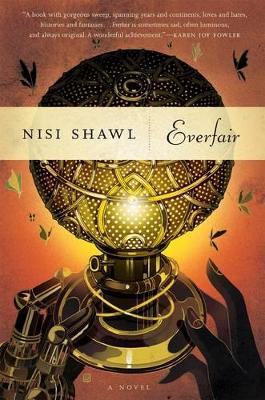Reviewed by Heather on
Laurie Albin has a complicated home life. He has a wife named Daisy with whom he has children. He has a secretary/mistress named Ellen living in his house with whom he also has children. He has just brought home Lisette, another mistress. He has also decided to move his whole family to Africa to help set up a new country. He promptly then abandons Daisy, Lisette, and most of the children when he heads back to England with Ellen and one son forever. They don't really miss him though. Daisy and Lisette have been lovers since Laurie brought Lisette home.
That's just part of one family to keep track of in this sweeping stories that takes place over decades in many countries across Africa and with a huge cast of characters.
The British settlers are one aspect of Everfair. There are also African-American missionaries led by Mrs. Hunter. She's a woman who believes that absolutely nothing is more important than converting souls to Christianity. She'll stand in the way of humanitarian aid if it doesn't include Bibles. She'll refuse to work with other people for the good of everyone if they aren't Christian. She also is upset with the French woman Lisette because she is mixed race but living the life of a European white woman.
Tink is a Chinese man who was being held by Leopold's men. He escaped and now is the mechanical guru of Everfair. He loves making ever more advanced artificial limbs for people maimed in wars. He invents better and better airships.
King Mwenda and Queen Josina are the African leaders of the area that Leopold seized and then sold to the colonists of Everfair. They maintain that it is still their land to govern. They were willing to work with the colonists to get rid of the Belgians but now they want to take control back.
Other characters come and go. The book takes place between 1889 and 1919. There can be large jumps in time and/or place between chapters. It is important to pay close attention to the notations of where and when the action is taking place.
I think this book was ambitious in its scope and ultimately didn't stand up to it. There is so much going on that some story lines just disappear. There are characters that are in the story and then you just never hear from again.
I enjoyed the characters and their interactions with each other. But there was a time when a character heard that another war was looming and expressed frustration that there was yet another one. I felt the same way. It was one world conflict after another with a lot of the time in between compressed or skipped over.
The technology that is so important in the steampunk genre didn't feel fully formed either. The imaginative artificial limbs were wonderful. Everyone had several to wear for different occasions. Some were weaponized. Others were just pretty. I didn't get a great feel for the airships though. They were being powered with some sort of local magic earth that was never explained. I wasn't sure if that was supposed to be a nod to the uranium of the area or not.
This is a hard book to decide if I liked it or not. What is on the page is interesting and worth reading but you are left with a sense that something is missing. It could have been more. Perhaps if the scope was narrowed, it could have gone more in depth and I would have liked the overall story more.
This review was originally posted on Based On A True Story
Reading updates
- Started reading
- 22 September, 2016: Finished reading
- 22 September, 2016: Reviewed
